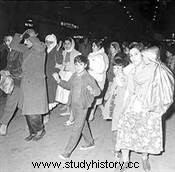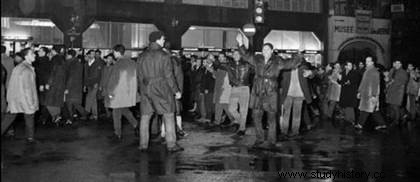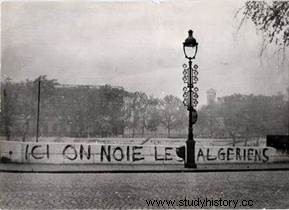 October 17, 1961 , in the midst of the Algerian war and at the call of the FLN, thousands of demonstrators marched without violence in a Paris under tension. The reaction of the police, led by a certain Maurice Papon, is very violent:the demonstrators are pursued and beaten up, thrown into the Seine or arrested. The balance sheet - a major subject of controversy - is very heavy. However, the event, like Sétif (May 8, 1945), despite its scale and violence, remains fifty years later still little known to the public. In 2012, President François Hollande acknowledged the responsibility of the state in this massacre.
October 17, 1961 , in the midst of the Algerian war and at the call of the FLN, thousands of demonstrators marched without violence in a Paris under tension. The reaction of the police, led by a certain Maurice Papon, is very violent:the demonstrators are pursued and beaten up, thrown into the Seine or arrested. The balance sheet - a major subject of controversy - is very heavy. However, the event, like Sétif (May 8, 1945), despite its scale and violence, remains fifty years later still little known to the public. In 2012, President François Hollande acknowledged the responsibility of the state in this massacre.
The context in October 1961
The year 1961 was particularly turbulent with, among other things, the creation of the OAS (February), the putsch of the generals in Algiers (April) and the divisions within of the Algerian nationalist movement, which led to the departure of Ferhat Abbas (August).
Despite the negotiations between De Gaulle and the GPRA, tensions are very high:the OAS claims responsibility for attacks, including in mainland France, and the FLN attacks the French police (about thirty deaths since the beginning of 1961). This is the pretext taken by the prefecture of Paris, led by Maurice Papon, to impose a curfew on “French Muslims in Algeria” (and more broadly on immigrants). The FLN then calls for a boycott of this curfew by demonstrating, in a non-violent way, on October 17, 1961.
The demonstration of October 17, 1961 turns into a massacre
Their number is estimated at at least twenty thousand. If the weight of the FLN is undeniable, sometimes to the point of threat, the demonstrators are above all people who can no longer take the situation and the context. Many come from the slums of the Parisian suburbs and suffer, in addition to their social situation, the collateral damage of the war and a repression against the FLN which turns into blind raids. Other demonstrators will also come from further afield and thus try to be heard.
 The police set up in the afternoon of October 17. Demonstrators arriving from Parisian stations are already expected and for many turned back or arrested. The others, around twenty or thirty thousand therefore, manage to reach the various places of the demonstration in Paris, on the Grands Boulevards, at Etoile and on Saint-Michel and Saint-Germain.
The police set up in the afternoon of October 17. Demonstrators arriving from Parisian stations are already expected and for many turned back or arrested. The others, around twenty or thirty thousand therefore, manage to reach the various places of the demonstration in Paris, on the Grands Boulevards, at Etoile and on Saint-Michel and Saint-Germain.
The march really starts from 8 p.m., when the curfew is supposed to start. There are young men, but also older ones, as well as women and children. The first arrests begin, but the processions continue. The demonstrators chant slogans such as "Algerian Algeria", "FLN in power" and "Racists at the post".
The situation tensed around 9:30 p.m. Shots ring out, the police charge at the Opera, then near the Rex cinema; Arrests are on the rise, with apprehended protesters being taken to identification centers (where the violence continues). Everything accelerated shortly before 10 p.m., and violence exploded at all the places of the demonstration, including near Nanterre. It's confusing in the middle of the night. The streets emptied of passers-by are the scene of chases between the police and demonstrators, some of whom throw themselves into the Seine to escape arrest. Others are voluntarily balanced there. We find bodies on the pavement at the Pont de Neuilly, at the Etoile, at Opéra, on the boulevards,...
Everything falls into place around midnight. More than ten thousand demonstrators were arrested! New demonstrations are planned for the following days, but the authorities have every intention of regaining control of events. Raids began the next day, in particular in Nanterre, which for some led to expulsions...
The report of October 17, 1961
If the number of arrests is not particularly controversial, that of the number of deaths continues to do so. The most reliable estimates (Benjamin Stora for example) speak of at least two hundred dead. The lowest estimates suggest several dozen deaths, which is already enormous, even in this very tense context.
 However, the other significant fact is the quasi omerta which is set up as of the following days, in spite of the magnitude of the event. Admittedly, the press present despite the censorship publishes very critical articles, but that is not enough. It is above all politically that we decide to erase this October 17, and within the police despite an attempt by “Republican police officers” to report on the violence of the night. No one is worried, and obviously in the first place Maurice Papon. We go so far as to accuse FLN commandos of being responsible for the deaths (deaths previously denied). A commission of inquiry is buried at the end of the year. The bloody events of Charonne, in February 1962, marked the left in struggle with the OAS more deeply than on October 17. Then it is political pragmatism (some would say cynicism) that takes over, including on the side of the FLN. You have to know how to ignore some bad memories to get back to the negotiating table.
However, the other significant fact is the quasi omerta which is set up as of the following days, in spite of the magnitude of the event. Admittedly, the press present despite the censorship publishes very critical articles, but that is not enough. It is above all politically that we decide to erase this October 17, and within the police despite an attempt by “Republican police officers” to report on the violence of the night. No one is worried, and obviously in the first place Maurice Papon. We go so far as to accuse FLN commandos of being responsible for the deaths (deaths previously denied). A commission of inquiry is buried at the end of the year. The bloody events of Charonne, in February 1962, marked the left in struggle with the OAS more deeply than on October 17. Then it is political pragmatism (some would say cynicism) that takes over, including on the side of the FLN. You have to know how to ignore some bad memories to get back to the negotiating table.
October 17, 1961 remains an issue of debate until today, as shown by the controversies that arise on the occasion of the commemoration of the fifty years of what it is necessary to qualify a massacre of State.
Bibliography
- B. Stora, History of the Algerian War (1954-1962) , The Discovery, 2004.
- M. Lévine, Les ratonnades d’October. A collective murder in Paris in 1961 , Ramsay, 1985.
-J-P. Brunet, Police versus FLN. The drama of October 1961 , Flammarion, 1999.
-J-L. Einaudi, The Battle of Paris:October 17, 1961 , Threshold, 1991.
-J-L. Einaudi, October 1961. A massacre in Paris , Fayard, 2001.
